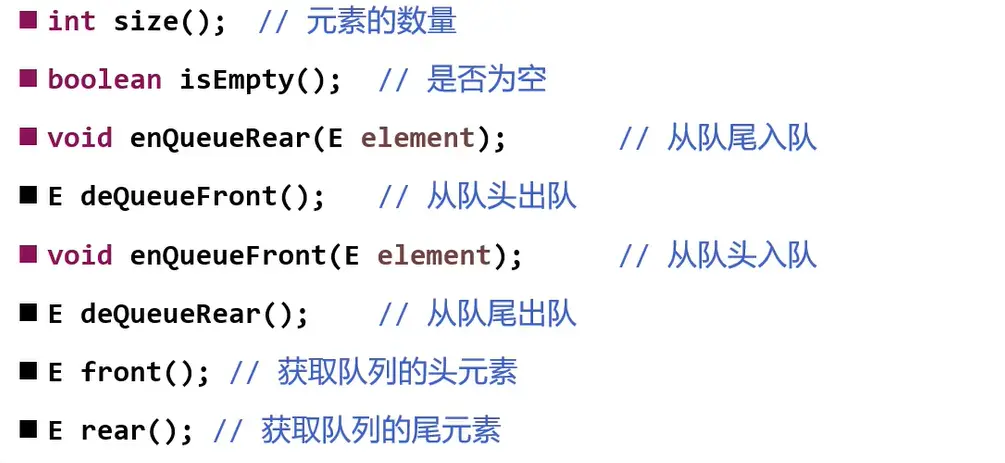 队列
队列
# 队列
# 简介
队列是一种特殊的线性表,只能在头尾两端进行操作
- 队尾 (rear) : 只能从队尾添加元素,一般叫做
enQueue,入队 - 队头 (front) : 只能从队头移除元素,一般叫做
deQueue,出队 - 先进先出的原则,First In First Out,FIFO
# 接口设计
优先考虑双向链表

代码实现
public class Queue<E> {
private List<E> list = new LinkedList<>();
public int size() {
return list.size();
}
public boolean isEmpty() {
return list.isEmpty();
}
public void clear() {
list.clear();
}
public void enQueue(E element) {
list.add(element);
}
public E deQueue() {
return list.remove(0);
}
public E front() {
return list.get(0);
}
}
1
2
3
4
5
6
7
8
9
10
11
12
13
14
15
16
17
18
19
20
21
22
23
24
25
26
27
2
3
4
5
6
7
8
9
10
11
12
13
14
15
16
17
18
19
20
21
22
23
24
25
26
27
# Queue 源码分析
入队:boolean offer(E, e)
出队:E poll()
获取队头元素:E peek()
对比 LinkedList 和 Queue
java.util.LinkedList<Interger> linkedList;
java.util.Queue<Integer> queue;
1
2
2
其实 LinkedList 实现了 Deque 接口,而 Deque 接口又实现了 Queue 接口
public class LinkedList<E>
extends AbstractSequentialList<E>
implements List<E>, Deque<E>, Cloneable, java.io.Serializable {
}
1
2
3
4
2
3
4
总结:
根据源码,不难发现,队列(Queue) 就是通过 LinkedList 来实现的
# 双端队列(Deque)
双端队列是能在头尾两段添加、删除的队列
deque(double ended queue)
接口设计

代码实现
基于链表实现接口功能
public class Deque<E> {
private List<E> list = new LinkedList<>();
public int size() {
return list.size();
}
public boolean isEmpty() {
return list.isEmpty();
}
public void clear() {
list.clear();
}
public void enQueueRear(E element) {
list.add(element);
}
public E deQueueFront() {
return list.remove(0);
}
public void enQueueFront(E element) {
list.add(0, element);
}
public E deQueueRear() {
return list.remove(list.size() - 1);
}
public E front() {
return list.get(0);
}
public E rear() {
return list.get(list.size() - 1);
}
}
1
2
3
4
5
6
7
8
9
10
11
12
13
14
15
16
17
18
19
20
21
22
23
24
25
26
27
28
29
30
31
32
33
34
35
36
37
38
39
2
3
4
5
6
7
8
9
10
11
12
13
14
15
16
17
18
19
20
21
22
23
24
25
26
27
28
29
30
31
32
33
34
35
36
37
38
39
# 循环队列
循环队列 底层用 动态数组 实现的写法如下(也可用链表)
代码实现
public class CircleQueue<E> {
private int front;
private int size;
private E[] elements;
private static final int DEFAULT_CAPACITY = 10;
public CircleQueue() {
elements = (E[]) new Object[DEFAULT_CAPACITY];
}
public int size() {
return size;
}
public boolean isEmpty() {
return size == 0;
}
public void clear() {
for (int i = 0; i < size; i++) {
elements[index(i)] = null;
}
front = 0;
size = 0;
}
public void enQueue(E element) {
ensureCapacity(size + 1);
elements[index(size)] = element;
size++;
}
public E deQueue() {
E frontElement = elements[front];
elements[front] = null;
front = index(1);
size--;
return frontElement;
}
public E front() {
return elements[front];
}
@Override
public String toString() {
StringBuilder string = new StringBuilder();
string.append("capcacity=").append(elements.length)
.append(" size=").append(size)
.append(" front=").append(front)
.append(", [");
for (int i = 0; i < elements.length; i++) {
if (i != 0) {
string.append(", ");
}
string.append(elements[i]);
}
string.append("]");
return string.toString();
}
/**
* 获取循环队列中的真实索引
* 索引映射封装
*/
private int index(int index) {
index += front;
return index - (index >= elements.length ? elements.length : 0);
}
/**
* 保证要有capacity的容量
* @param capacity
*/
private void ensureCapacity(int capacity) {
int oldCapacity = elements.length;
if (oldCapacity >= capacity) return;
// 新容量为旧容量的1.5倍
int newCapacity = oldCapacity + (oldCapacity >> 1);
E[] newElements = (E[]) new Object[newCapacity];
for (int i = 0; i < size; i++) {
newElements[i] = elements[index(i)];
}
elements = newElements;
// 重置front
front = 0;
}
}
1
2
3
4
5
6
7
8
9
10
11
12
13
14
15
16
17
18
19
20
21
22
23
24
25
26
27
28
29
30
31
32
33
34
35
36
37
38
39
40
41
42
43
44
45
46
47
48
49
50
51
52
53
54
55
56
57
58
59
60
61
62
63
64
65
66
67
68
69
70
71
72
73
74
75
76
77
78
79
80
81
82
83
84
85
86
87
88
89
90
91
92
2
3
4
5
6
7
8
9
10
11
12
13
14
15
16
17
18
19
20
21
22
23
24
25
26
27
28
29
30
31
32
33
34
35
36
37
38
39
40
41
42
43
44
45
46
47
48
49
50
51
52
53
54
55
56
57
58
59
60
61
62
63
64
65
66
67
68
69
70
71
72
73
74
75
76
77
78
79
80
81
82
83
84
85
86
87
88
89
90
91
92
# 循环双端队列
循环双端队列:可以进行两端添加、删除操作的循环队列
代码
主要代码部分:
- 从头部入队
- 从尾部出队
public class CircleDeque<E> {
private int front; // 头元素下标
private int size;
private E[] elements;
private static final int DEFAULT_CAPACITY = 10;
public CircleDeque() {
elements = (E[]) new Object[DEFAULT_CAPACITY];
}
public int size() {
return size;
}
public boolean isEmpty() {
return size == 0;
}
public void clear() {
for (int i = 0; i < size; i++) {
elements[index(i)] = null;
}
front = 0;
size = 0;
}
/**
* 从尾部入队
* @param element
*/
public void enQueueRear(E element) {
ensureCapacity(size + 1);
elements[index(size)] = element;
size++;
}
/**
* 从头部出队
* @param element
*/
public E deQueueFront() {
E frontElement = elements[front];
elements[front] = null;
front = index(1);
size--;
return frontElement;
}
/**
* 从头部入队
* @param element
*/
public void enQueueFront(E element) {
ensureCapacity(size + 1);
front = index(-1);
elements[front] = element;
size++;
}
/**
* 从尾部出队
* @param element
*/
public E deQueueRear() {
int rearIndex = index(size - 1);
E rear = elements[rearIndex];
elements[rearIndex] = null;
size--;
return rear;
}
public E front() {
return elements[front];
}
public E rear() {
return elements[index(size - 1)];
}
@Override
public String toString() {
StringBuilder string = new StringBuilder();
string.append("capcacity=").append(elements.length)
.append(" size=").append(size)
.append(" front=").append(front)
.append(", [");
for (int i = 0; i < elements.length; i++) {
if (i != 0) {
string.append(", ");
}
string.append(elements[i]);
}
string.append("]");
return string.toString();
}
private int index(int index) {
index += front;
if (index < 0) {
return index + elements.length;
}
return index - (index >= elements.length ? elements.length : 0);
}
/**
* 保证要有capacity的容量
* @param capacity
*/
private void ensureCapacity(int capacity) {
int oldCapacity = elements.length;
if (oldCapacity >= capacity) return;
// 新容量为旧容量的1.5倍
int newCapacity = oldCapacity + (oldCapacity >> 1);
E[] newElements = (E[]) new Object[newCapacity];
for (int i = 0; i < size; i++) {
newElements[i] = elements[index(i)];
}
elements = newElements;
// 重置front
front = 0;
}
}
1
2
3
4
5
6
7
8
9
10
11
12
13
14
15
16
17
18
19
20
21
22
23
24
25
26
27
28
29
30
31
32
33
34
35
36
37
38
39
40
41
42
43
44
45
46
47
48
49
50
51
52
53
54
55
56
57
58
59
60
61
62
63
64
65
66
67
68
69
70
71
72
73
74
75
76
77
78
79
80
81
82
83
84
85
86
87
88
89
90
91
92
93
94
95
96
97
98
99
100
101
102
103
104
105
106
107
108
109
110
111
112
113
114
115
116
117
118
119
120
121
122
123
124
125
126
127
2
3
4
5
6
7
8
9
10
11
12
13
14
15
16
17
18
19
20
21
22
23
24
25
26
27
28
29
30
31
32
33
34
35
36
37
38
39
40
41
42
43
44
45
46
47
48
49
50
51
52
53
54
55
56
57
58
59
60
61
62
63
64
65
66
67
68
69
70
71
72
73
74
75
76
77
78
79
80
81
82
83
84
85
86
87
88
89
90
91
92
93
94
95
96
97
98
99
100
101
102
103
104
105
106
107
108
109
110
111
112
113
114
115
116
117
118
119
120
121
122
123
124
125
126
127
# 模运算优化
尽量避免使用【乘*、除/、模%、浮点数】运算,效率低下
代码修改
// 循环队列
private int index(int index) {
index += front;
return index - (index >= elements.length ? elements.length : 0);
}
// 循环双端队列
private int index(int index) {
index += front;
if (index < 0) {
return index + elements.length;
}
return index - (index >= elements.length ? elements.length : 0);
}
1
2
3
4
5
6
7
8
9
10
11
12
13
14
2
3
4
5
6
7
8
9
10
11
12
13
14
注意前提条件:
- 已知
n >= 0,m > 0 n % m等价于n - (m > n ? 0 : m)的前提条件: n < 2m
# 循环队列 clear 细节
public void clear() {
for (int i = 0; i < size; i++) {
// 获取真实索引元素
elements[index(i)] = null;
}
front = 0;
size = 0;
}
1
2
3
4
5
6
7
8
2
3
4
5
6
7
8
# 练习
# 232.用栈实现队列
思路:
准备 2 个栈: inStack、outStack
入队时,push 到 inStack 中
出队时
如果 outStack 为空,将 inStack 所有元素逐一弹出,push 到 outStack,outStack 弹出栈顶元素
如果 outStack 不为空,outStack 弹出栈顶元素
代码实现:
class MyQueue {
private Stack<Integer> inStack;
private Stack<Integer> outStack;
public MyQueue() {
inStack = new Stack<>();
outStack = new Stack<>();
}
/** 入队 */
public void push(int x) {
inStack.push(x);
}
/** 出队 */
public int pop() {
checkOutStack();
return outStack.pop();
}
/** 获取队头元素 */
public int peek() {
checkOutStack();
return outStack.peek();
}
/** 是否为空 */
public boolean empty() {
return inStack.isEmpty() && outStack.isEmpty();
}
private void checkOutStack() {
if (outStack.isEmpty()) {
while (!inStack.isEmpty()) {
outStack.push(inStack.pop());
}
}
}
}
1
2
3
4
5
6
7
8
9
10
11
12
13
14
15
16
17
18
19
20
21
22
23
24
25
26
27
28
29
30
31
32
33
34
35
36
37
38
39
40
2
3
4
5
6
7
8
9
10
11
12
13
14
15
16
17
18
19
20
21
22
23
24
25
26
27
28
29
30
31
32
33
34
35
36
37
38
39
40
# 225.用队列实现栈
上次更新: 2024/9/25 11:16:13
